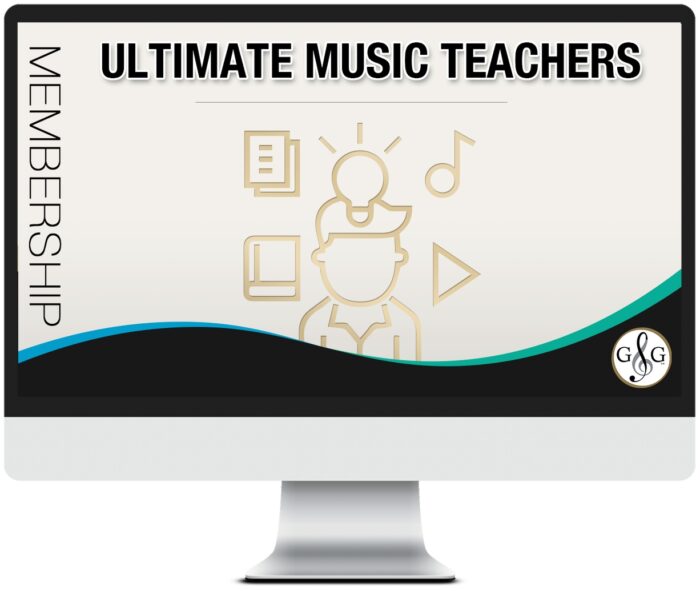How to Teach Music Theory Beginner A Lesson 6
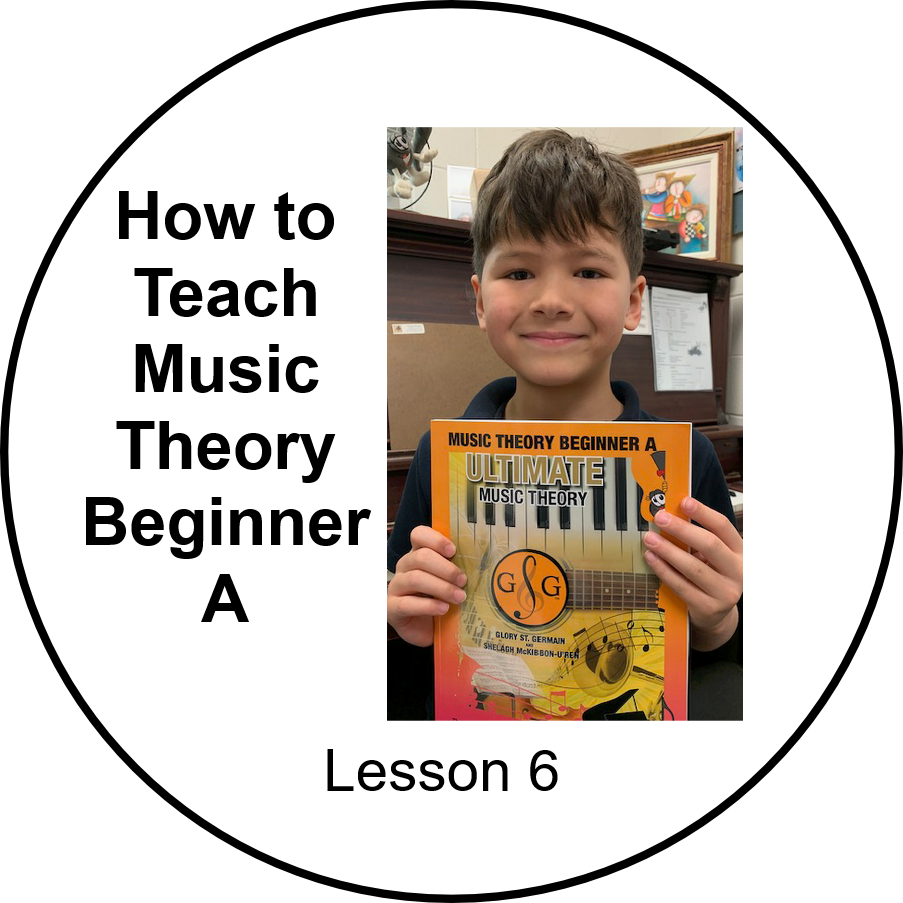
Welcome to the How to Teach Ultimate Music Theory Beginner A Workbook Series - Lesson 6.
The Ultimate Music Theory Beginner A, B and C Workbook Series is the perfect theory supplement for Beginner Students (ALL ages, ANY instrument). The UMT Beginner A, B, C Series works with every Method Series and with every Learning Style.
In this Blog, we will look at how to teach the concepts in the Music Theory Beginner A Workbook Lesson 6. Remember to read the first 6 Blogs in this series:
Music Theory Beginner A Overview
Music Theory Beginner A - Lesson 1
Music Theory Beginner A - Lesson 2
Music Theory Beginner A - Lesson 3
Music Theory Beginner A - Lesson 4
Music Theory Beginner A - Lesson 5
Join me as we explore tips and tricks to incorporate theory, ear training, sight reading and games into every lesson. Let's jump in!
How to Teach Music Theory Beginner A Pages 34 & 35
It is so exciting when our young students get to these pages and learn the Musical Alphabet! Often the easiest way to teach this is to start with the lowest A on the piano, and continue up the keyboard repeating the Musical Alphabet. However, this only works when playing on an acoustic piano or a full-sized digital keyboard.
An acoustic piano produces sound when a key is depressed (played) and felt-covered hammers hit steel-wire strings inside of the piano. An acoustic piano does not plug in. (I always know that a student practices on a digital piano when they look for the on-button on my studio acoustic piano!)
An acoustic piano basically fits in one of 2 categories - the Grand Piano and the Upright Piano. The modern acoustic piano will have 88 keys with the lowest key being a white key A, and the highest key being a white key C,
A digital piano or digital keyboard produces sound when a key is depressed causing the sound to be replicated electronically and played back through speakers. A digital piano has an on/off button and must plug in to an electrical outlet (or use batteries).
There are different sizes of digital pianos (digital keyboards) with keyboards that have 33, 49, 61, 73, 76 or 88 keys.
I have had parents tell me that their child is playing on a "full sized keyboard" since the phrase "full-sized keys" is often a selling feature for digital pianos. This does not mean that the keyboard has 88 keys though - it only means that the individual keys that the digital piano has are the same size as "real" piano keys. So a keyboard can be shorter (have fewer keys) but still have "full sized keys".
Something that I have started doing is asking the parents of new students to send me a picture of their child as they sit at their piano. This allows me to check:
- the size of the keyboard;
- the type and height of the bench or stool;
- whether there actually is a stand to hold a music book.
Before you have your student practice saying the musical alphabet going up the keyboard, you need to know what their lowest key is!
You may notice on Page 34 that our Keyboard example does not start with the lowest key being "A". We did this on purpose so that students need to use the groups of black keys to find that first "A" (and not rely upon the lowest note on a keyboard always being an "A").
PS - If you are not certain what the "C4" on Middle C means, please check out my Blog on PIANO KEY NUMBERS here.
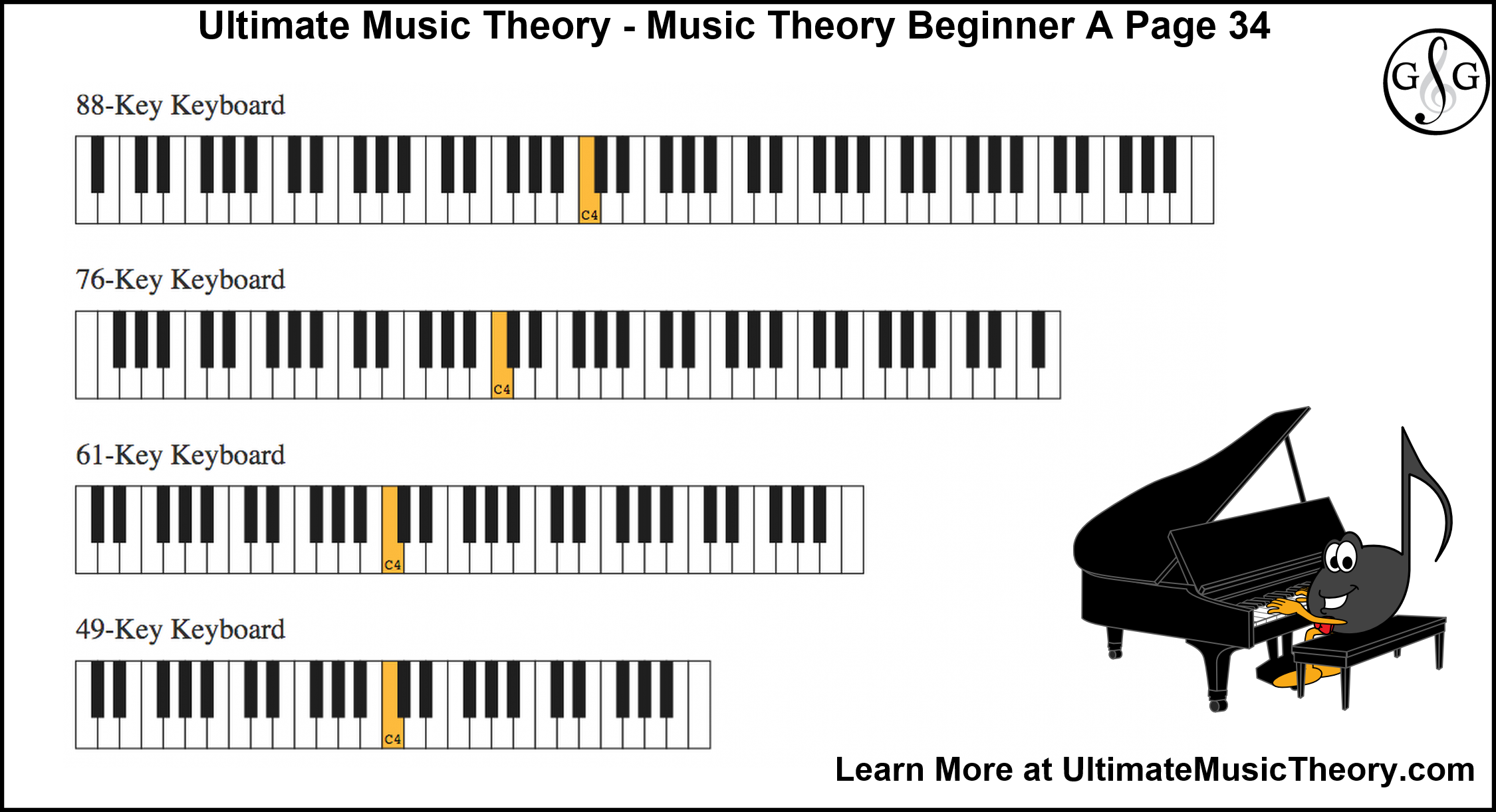
Llama Finger or Unicorn Finger?
In the Ultimate Music Theory Beginner A Workbook on Page 34, students learn about the Musical Alphabet going UP the keyboard. So, of course, we are going to want to "Say, Play and Write" that Musical Alphabet.
When I have my students play the Musical Alphabet going up (or down) the keyboard, I like to have them use their Left Hand Finger #2 or #3 for notes below Middle C, and their Right Hand Finger #2 or #3 for notes above Middle C.
I know that this has absolutely nothing to do with Theory, but when we do this playing exercise, I will explain the difference between playing with a "Unicorn Finger" versus playing with a "Llama Finger".
A "Unicorn Finger", like a Unicorn's horn, is a straight, hard finger that has no bounce to it. When you play with a "Unicorn Finger", you risk the chance of jamming your joint because the finger is rigid and has no "give" to it.
A "Llama Finger", like a Llama's mouth, is a curved, flexible finger. When you play a key with a "Llama Finger", you have a bit of a bounce and bend to your finger. It is gentle on your joints too! (I call it a "Llama Finger" as there is an Action Song called "Happy Llama, Sad Llama, Totally Rad Llama" that I learned as a Kids Camp Counselor to sing around the campfire. You can check it out on YouTube.)
So when your student is playing these Musical Alphabet exercises on the piano, please spend a moment to make sure they are playing "safely". We do not want any damaged joints or fingers!
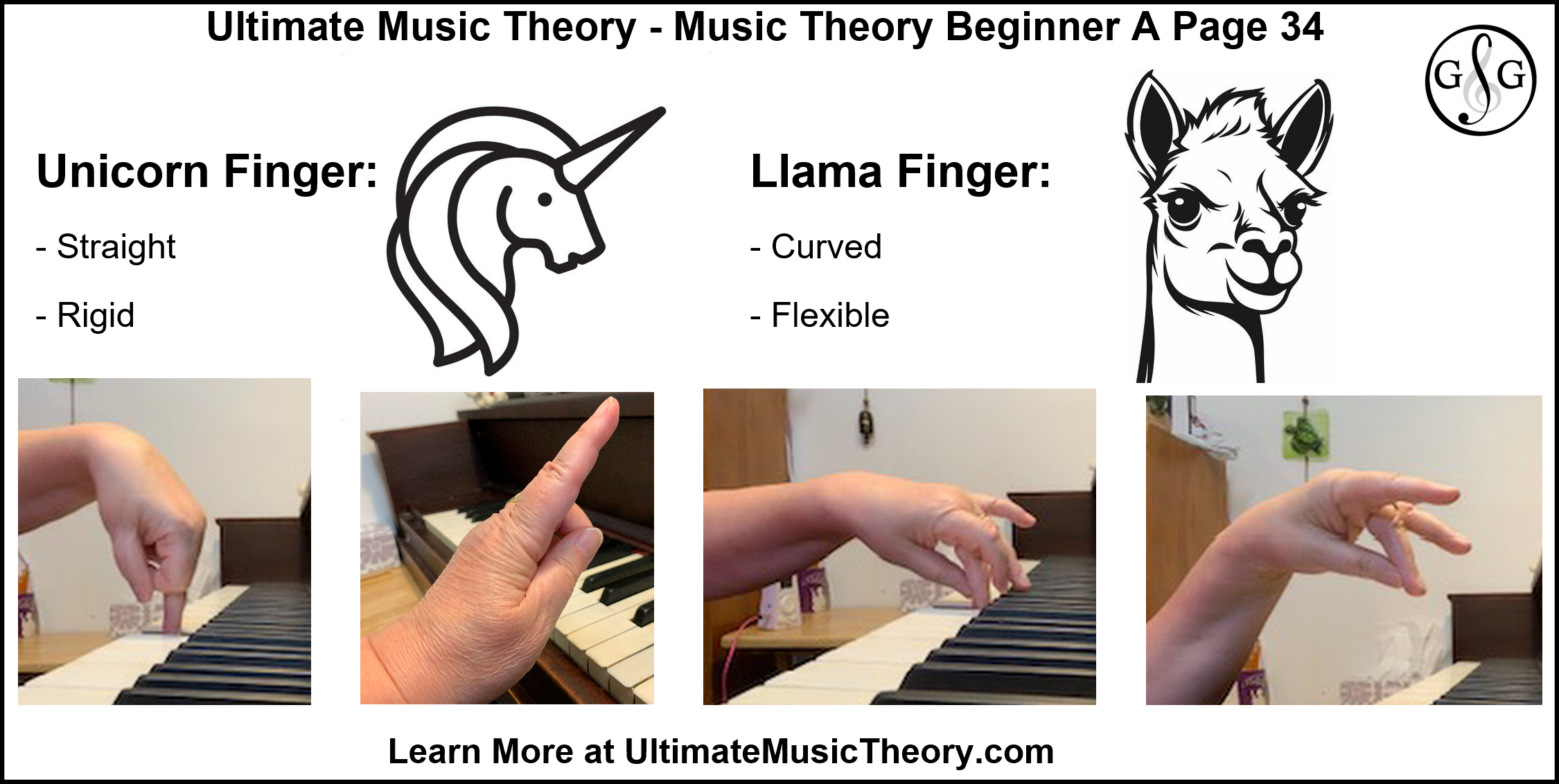
Blue Arrow = Going UP!
As I have mentioned in previous Blogs, I like to use crayons or pencil crayons to trace "up arrows" in Blue. I use blue because "the blue sky is up high". This reinforces that going up is a direction that goes up high to the sky.
When we read through Pages 34 & 35 at the lesson, I will have the student trace all the UP arrows blue. (They can complete the rest of the writing work either at the lesson or at home.)
After our writing work is complete, we must play that Musical Alphabet going up the keyboard. Remember to play with "Llama Fingers"!
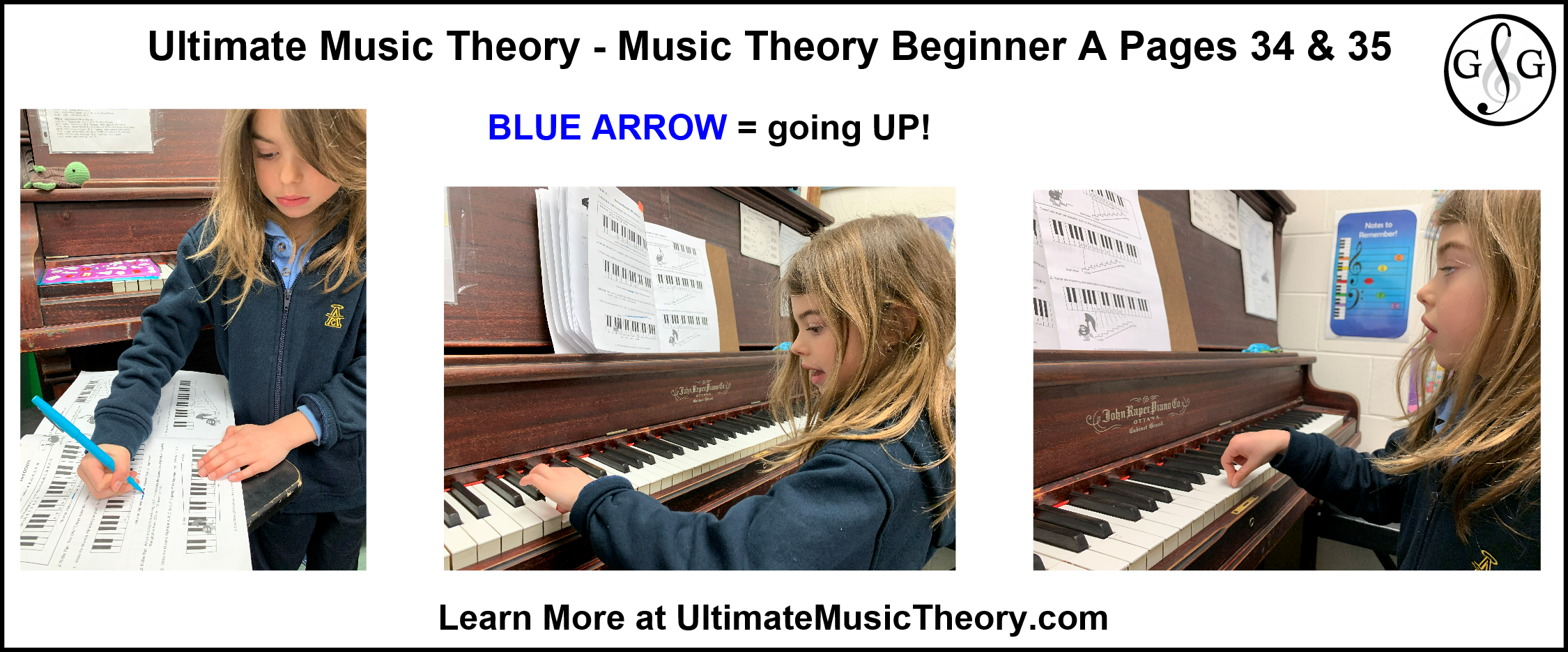
Green Arrow = Going DOWN!
On Pages 36 and 37, at our lesson we will trace all going DOWN arrows green. (Green grass is down on the ground.)
You do not have to do this - it is not an instruction in the Workbook. However, it is something that I do with all my students who use the Ultimate Music Theory Beginner Workbook A since it is a reinforcement - a reminder - of directions.
The writing on these 2 pages can be completed at the lesson or at home. (I usually just assign these to be completed at home.) However, when I mark them at the lesson, I do have the student show me how to play the Musical Alphabet going DOWN from HIGH to LOW.
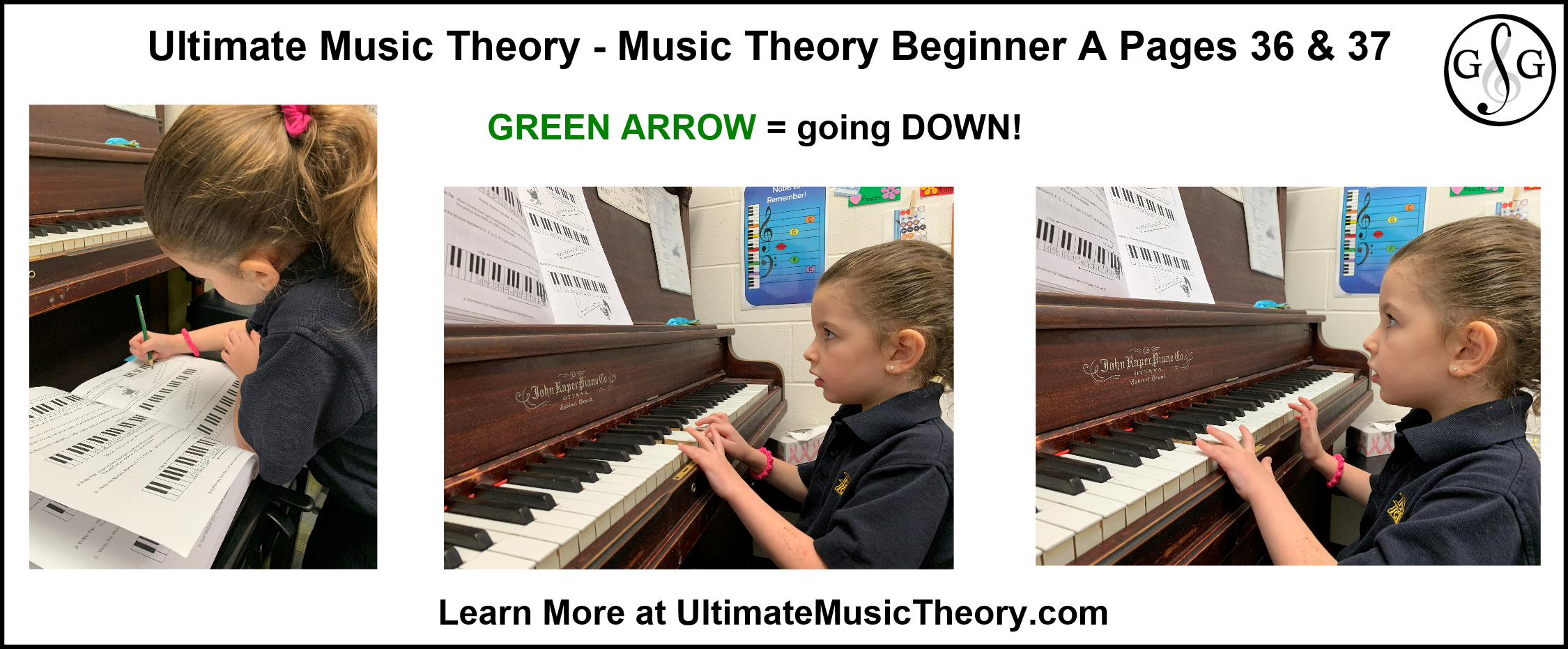
How to Teach Music Theory Beginner A Pages 38 & 39
I prefer to assign Page 38 as a homework page (for the Student to complete at home). Even with my younger students who are not comfortable reading instructions, it is pretty easy to see what has to be completed on this page.
Then, Page 39 is always completed at the lesson. I like to complete the first 2 boxes in question #1 with me playing the up or down Musical Alphabets (and the student circling the correct ascending or descending Musical Alphabet). Then I give the Student the opportunity to "Be the Teacher" if they want to play the Musical Alphabets in the 3rd & 4th boxes, and have me tell them whether they played going UP or going DOWN.
Some children like to complete all the listening work and others like to "Be the Teacher". Either way, they are learning.
Now - have you ever sung the Musical Alphabet Song? This is such a fun way to remember the Musical Alphabet ascending and descending.
The tune is "Twinkle, Twinkle, Little Star" and we repeat the Musical Alphabet going UP and then going DOWN. When we sing this little song with our Students, "So-La Says" to sing it first with a LOW voice, then a MIDDLE voice and then a HIGH voice. (The student is not expected to play this. The Teacher plays it and sings along with the student.)
I play this song starting on C3 (the octave below middle C) for my "LOW" voice. Can I sing in pitch this low? Nope, not at all. But we sure do have fun seeing how low we can sing (just like grumpy grizzly bears).
Our "MIDDLE" voice starts on Middle C - C4. Usually we can sing this in pitch, but I do not worry about singing exactly in pitch.
Then our "HIGH" voice starts on C5 - the C an octave above Middle C. Again, it is the attempt that matters and not being exactly in pitch!
At this point, I discuss with my students what low, middle and high voices are - they are the PITCH. So we can change the pitch of a song by singing it higher or lower.
Then we want to discuss what else can we change about our song? Please note - these next concepts have not been taught in the Ultimate Music Theory Beginner A Workbook but they are concepts that your students should be hearing during their piano, instrumental or voice lessons. They are:
- Tempo - we can sing this song at a slow, fast or a medium speed.
- Dynamics - we can sing this song at a loud, soft or medium dynamic.
- Rhythm - we can "swing" the rhythm (making it a long/short feel)
When your student suggests (for example) that they can sing this song really softly, you get to "pre-teach" that the volume of sound - the loudness or softness - is called the dynamics.
I think that my favourite is when the student decides that they want to sing this song fast. I play the song as we sing together - you should hear how fast we can go! This is so much fun!
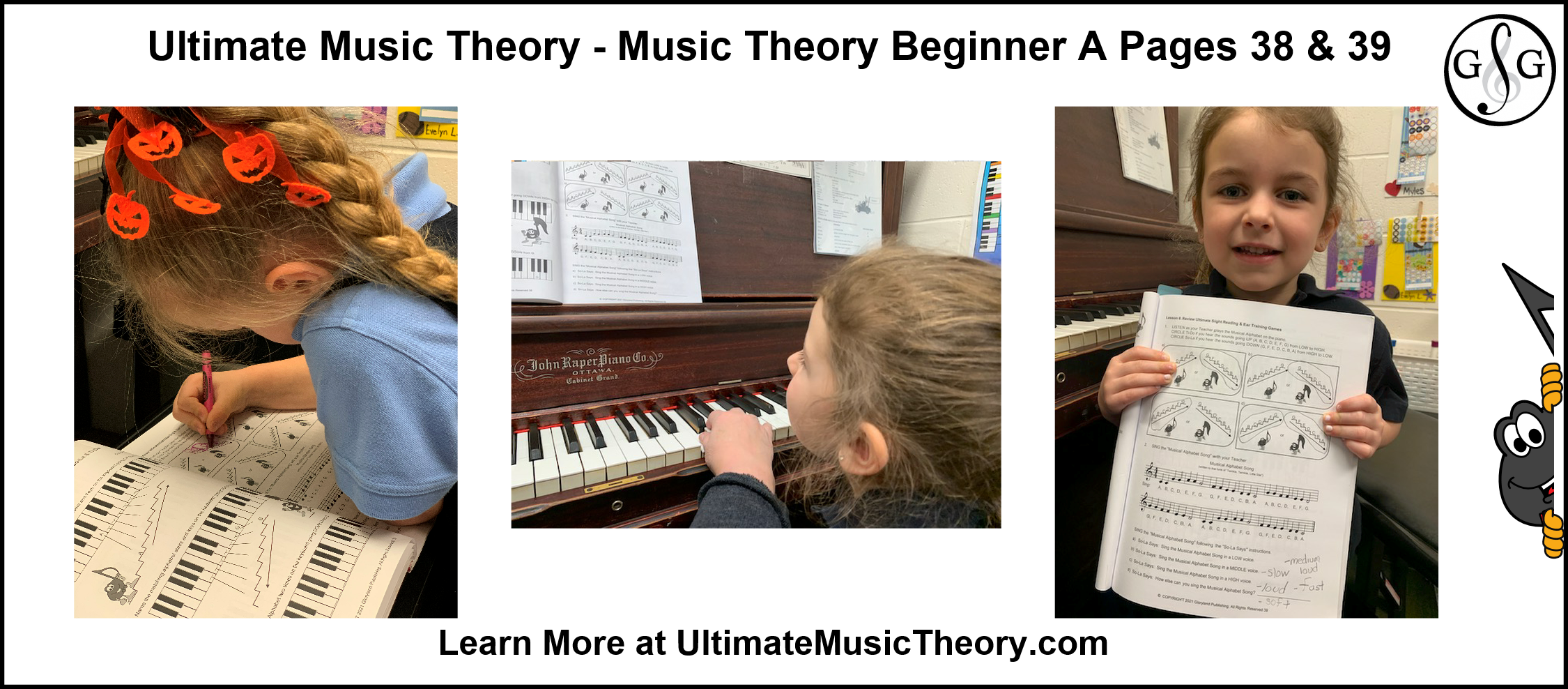
How to Teach Music Theory Beginner A Lesson 6 Flashcard Game
If you have time at the end of your lesson, grab your Flashcards! This is a great time to review all the Flashcards from pages 93 - 96. I mix them up and we play "Pick a Card, Any Card". I gather up 5 - 10 of the flashcards and, holding them like a deck of cards, I ask my student to "pick a card, any card". They have to either play or say the answer.
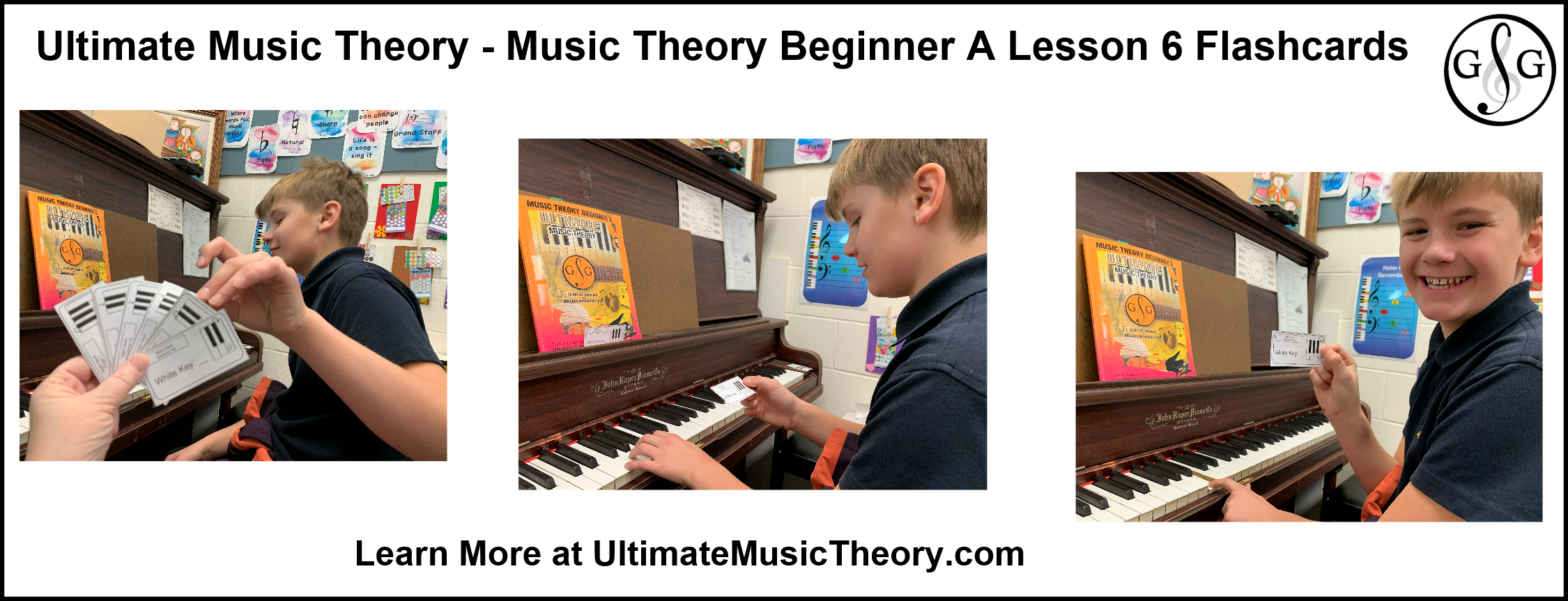
How to Teach Music Theory Beginner A Lesson 6
Each child will complete this lesson at their own pace. For some students, we complete 1 page a week, with 1 page assigned as a "bonus" page. (A "bonus" page is part of my Studio Challenge - students earn stickers on a Bingo Sheet by completing extra pages on their own.)
Some of my students are assigned 2 - 4 pages a week. Others can complete the entire lesson on their own each week. It all depends on the age and learning style of each student.
Some of my students need me to read each page with them at their lesson. Some of them don't - I just assign the pages and, after a quick review of the concept, they complete the work at home.
There is no "right or wrong" way to assign pages. Some students will complete this Workbook in 3 months, and others will take a full teaching year. Don't worry and just move at the speed that is comfortable for your student.
With a Smile and a Song,
Shelagh McKibbon-U'Ren
The Ultimate Music Theory Workbook Series - Beginner A, B, C, Prep 1, Prep 2, Basic, Intermediate, Advanced and Complete all-in-one Rudiments!

The UMT Workbooks include 12 Lessons & Review Tests, Music Theory Guide & Chart and 80 Flashcards in each workbook.
- 12 COMPREHENSIVE LESSONS - Simplify complex concepts
- GUIDE and CHART - Memory Joggers for fast and easy reference
- 12 REVIEW TESTS - Accumulative study including final exam
Ultimate Music Theory helps students prepare for nationally recognized theory exams, including the Royal Conservatory of Music Exams.
A Proven Step-by-Step Workbook System!
- LEARN FASTER – Use on any device, phone, tablet, computer
- EXPLORE – Identify written & audio notation
- PLAY – Sight Reading and Ear Training Games and much More!
Students will LOVE the UMT Flashcard System (App powered by Brainscape) that correlates to each lesson in the Beginner A, B, C, Prep 1, Prep 2, Basic, Intermediate & Advanced Workbooks.
Have fun building a foundation in Music Theory, Ear Training, and Sight Reading.
The One and ONLY Music Theory App & Matching Workbook!
Get Access To UMT Worksheets, Games, Activities, Posters, Certificates, Courses, Coaching Calls, Community & More!
Ultimate Music Teachers Membership
♪ LEARN ♪ PLAN ♪ TEACH ♪ GROW
The One & ONLY Ultimate Music Teachers Membership
To Become A UMT PRO!
Your Success Path Starts Here - Go To TeachUMT.com Today!
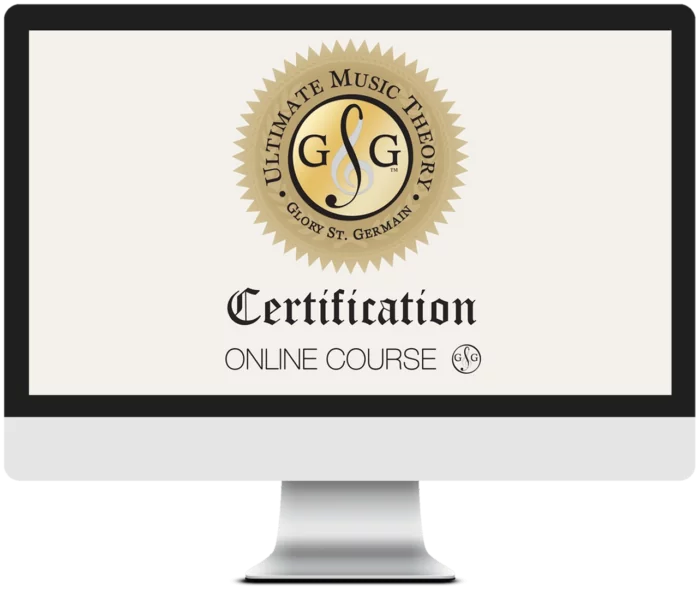
Ultimate Music Theory Certification Elite Educator Program - Online Teacher Training to Elevate Your Income, Impact Your Teaching and Grow Your Expert Music Teaching Business. Get Certified!
Click HERE to discover what you will learn in the Ultimate Music Theory Certification Course. Your professional development Online Teacher Training starts here!
Keep on Learning... With a Smile and a Song!
Shelagh McKibbon-U'Ren

